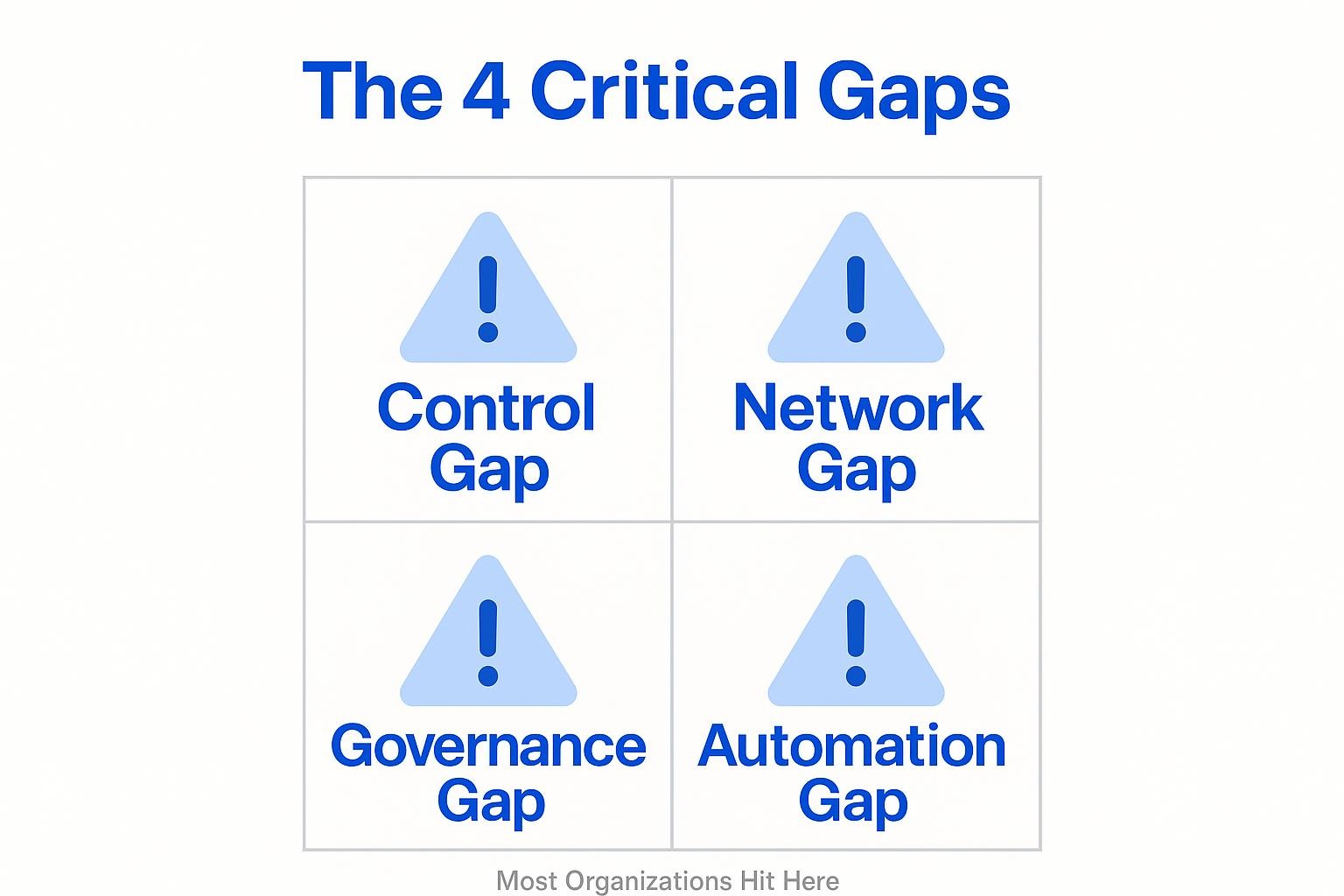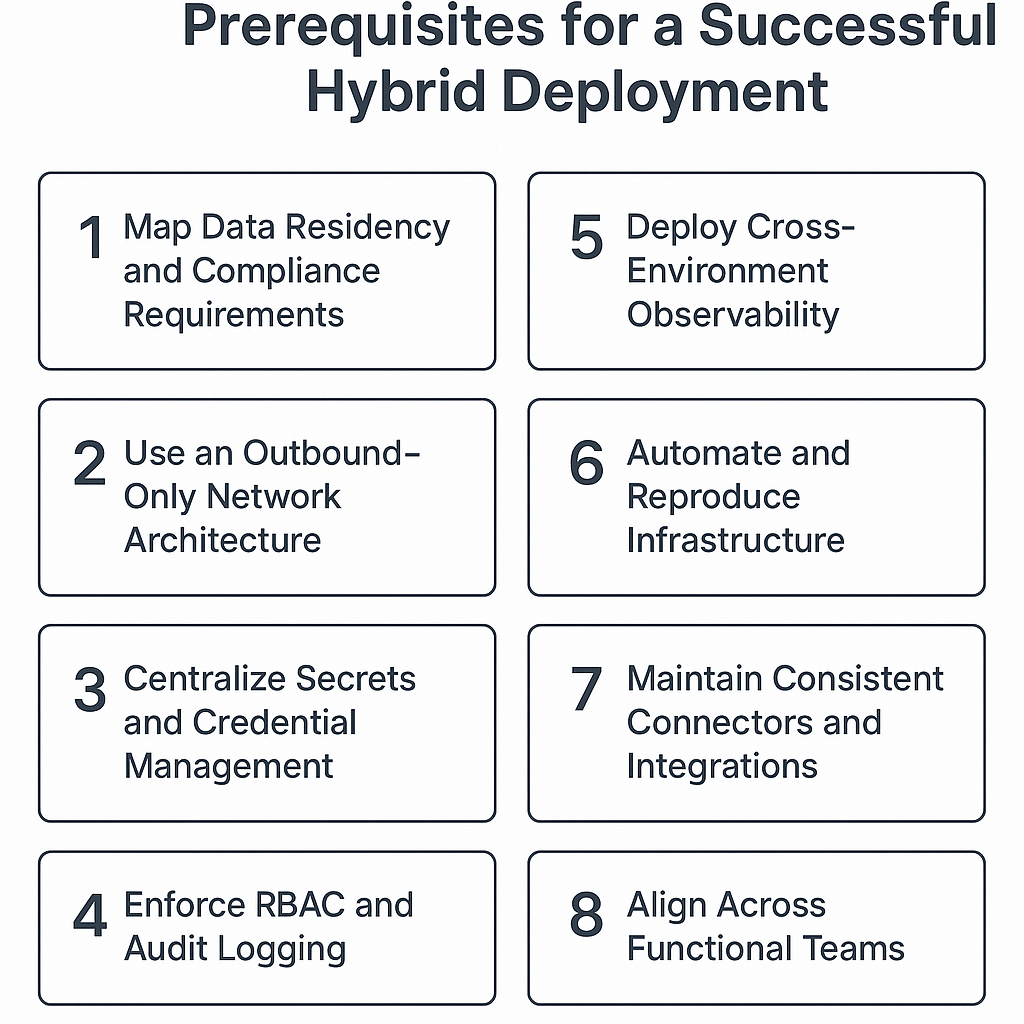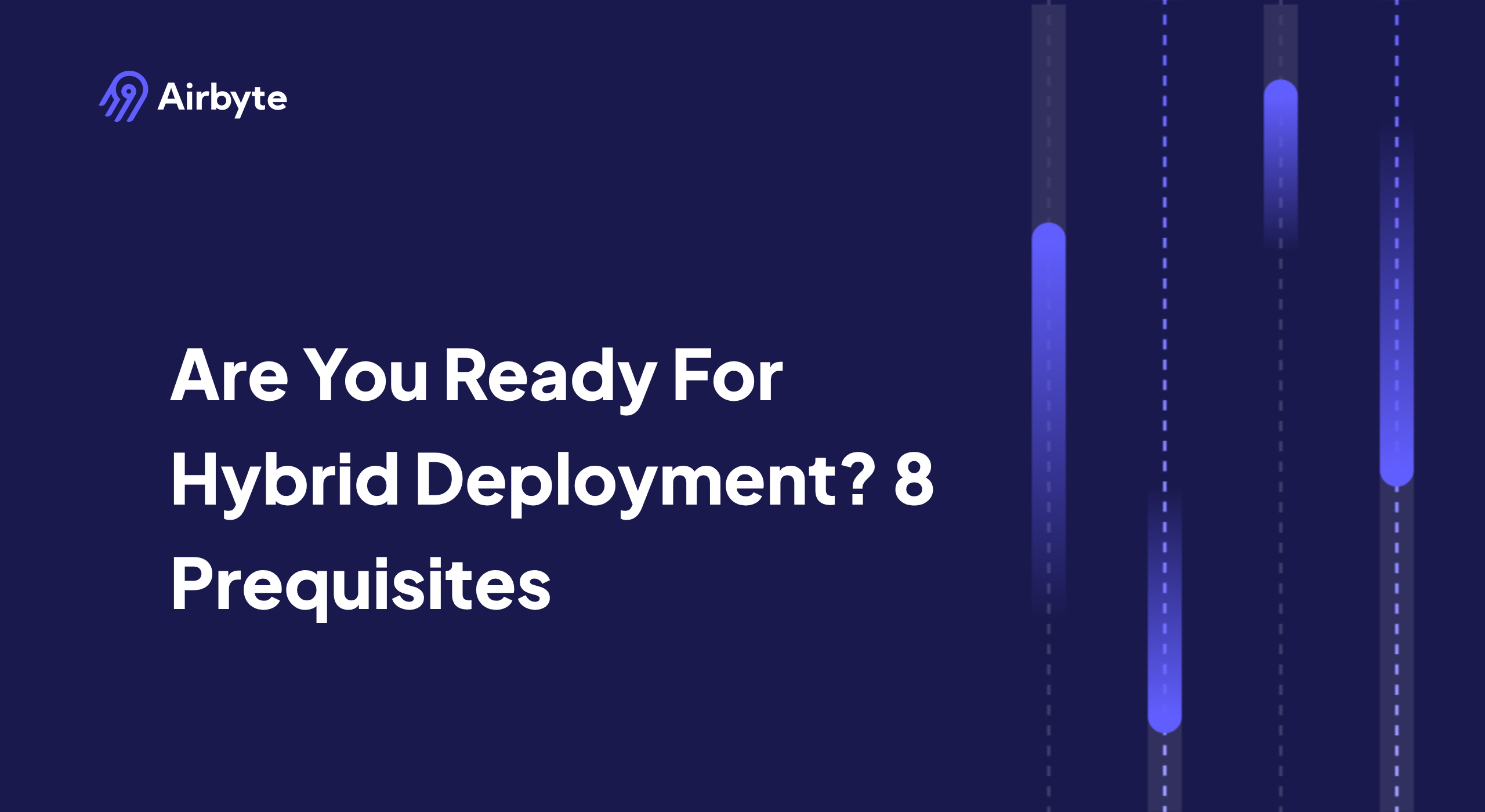Are You Ready For Hybrid Deployment? 8 Prerequisites
Summarize this article with:
✨ AI Generated Summary
Your team spent six months planning a hybrid rollout. Data planes deployed in your VPC, control plane managed in the cloud, everything connected. Then the compliance audit arrives. Turns out your infrastructure can't enforce consistent policies across environments. Your logs scatter across three systems. Your secrets live in config files. The deployment you thought was production-ready just became a six-month rebuild.
This happens because hybrid architecture demands more than connecting cloud and on-premises systems. You need centralized policy management, identity federation, and programmable networks spanning every environment. When regulations require data sovereignty or restrict cross-border transfers, you must architect for compliance from the start, not patch it later.
What follows are eight prerequisites that determine whether your hybrid deployment will meet compliance requirements or create new vulnerabilities. These come from real enterprise deployments where teams learned what works and what breaks under regulatory scrutiny.
Why Do Most Hybrid Deployments Fail Compliance Audits?

Teams rush toward hybrid because they want cloud elasticity without surrendering data control. Yet during the first compliance review, they discover four critical gaps.
- Control gap: When your control plane runs in a vendor's network, you lose visibility into where metadata lives and how credentials get accessed. Healthcare teams tell us they need control planes inside their own tenancy, not shared infrastructure. Manufacturing companies report that centralized management platforms only work when they run in customer-controlled environments.
- Network gap: We see financial services companies where firewall rules allow inbound traffic, breaking zero-trust principles. Any workload that relies on inbound SSH or public webhooks creates an entry point. Outbound-only patterns eliminate these exposed endpoints.
- Governance gap: Logs distributed across providers make audit trails impossible to verify. Unified monitoring stays optional rather than mandatory. A regional hospital faced scrutiny when regulators learned that job logs replicated to an external SIEM, potentially exposing PHI outside HIPAA controls.
- Automation gap: New data planes still launch by hand because Infrastructure as Code pipelines don't work across clouds. Teams spend weeks replicating configurations that should deploy in hours.
The fallout is real. A multinational bank's hybrid environment failed a DORA review when regulators learned that job orchestration executed in a US region while customer data stayed in the EU.
If you recognize any of these gaps in your own stack, the next step becomes clear: mapping the prerequisites that turn an aspirational hybrid project into a secure, compliant reality.
What Are the Prerequisites for a Successful Hybrid Deployment?
Successful hybrid implementation depends on eight critical capabilities. Miss any one, and you'll face control gaps, compliance failures, or operational problems that could have been avoided. Think of this as your readiness checklist. If you can't check every box, hold off on moving workloads between cloud and on-premises environments.

1. Have You Mapped Data Residency and Compliance Requirements?
Know exactly where every dataset can live. GDPR restricts personal data to the EEA unless you have explicit safeguards. HIPAA requires protected health information to stay safeguarded regardless of location.
Build a residency matrix documenting:
- Storage, processing, and replication locations
- Workloads that must stay on-premises or in specific regions
- Cloud zones that meet your jurisdictional requirements
Financial services teams maintain separate matrices for trading data (must stay in-region for T+0 reporting), customer PII (GDPR-restricted), and transaction logs (7-year retention). Healthcare organizations report similar complexity for ePHI, research data, and de-identified datasets.
2. Is Your Network Architecture Outbound-Only and Secure?
Every packet should originate inside your data plane. Nothing calls in from the public internet.
Airbyte Enterprise Flex follows this approach: the scheduler runs in the cloud control plane, but connectors initiate all traffic from behind your firewall. No need to open holes in your security perimeter.
Check your infrastructure: If any workload relies on inbound SSH or public webhooks, fix that before going hybrid. Manufacturing companies report that misconfigured ingress rules remain the top breach vector during parallel cloud migrations.
3. Do You Have Centralized Secrets and Credential Management?
Hard-coded passwords in config files or API keys passed through CI jobs create incidents waiting to happen.
Your vault must support:
- Short-lived tokens
- Automatic rotation
- Audit logging
Airbyte Enterprise Flex integrates with external vaults so connection strings never land in its metadata database. Telecom companies tell us they discovered API keys in Docker images, Kubernetes ConfigMaps, and even Terraform state files during their first audit.
4. Can You Enforce Role-Based Access and Immutable Audit Logging?
Regulators expect a forensic trail for every job, sync, or schema change, whether it runs in the cloud or your data center.
Implement unified controls:
- Role-based access control spanning both domains
- SSO integration so permissions follow users, not servers
- Immutable audit logs in write-once buckets
- Tamper-evident logging capturing who did what, when, and from where
Readiness test: Can you trace a dataset's entire lineage, including user clicks, to signed log entries? If not, tighten your control plane before migrating workloads.
5. Is Your Observability Framework Truly Cross-Environment?
You need one dashboard, not three, to spot lagging CDC pipelines or spiking error rates.
Deploy instrumentation that:
- Exports metrics, traces, and logs from both environments
- Uses OpenTelemetry collectors to scrub PII locally
- Maintains consistent trace IDs across domains
- Adapts alerting thresholds to region-specific latency
Airlines tell us unified logging proved critical during peak travel periods, when gate event processing spiked to sub-60-second latency requirements across edge data planes and central orchestration.

6. Is Your Infrastructure Automated and Reproducible?
Manual CLI sessions don't scale when cloning data planes across regions.
Infrastructure as Code requirements:
- Version-controlled templates for VPCs, Kubernetes manifests, IAM roles
- New environments spin up in minutes via terraform apply
- Drift detection alerts when configs change
- Full teardown and rebuild rehearsals before launch
Treat templates as your single source of truth. If the stack can't reappear identical to staging, keep iterating.
7. Are Your Connectors and Integrations Consistent Across Environments?
Some vendors split their catalogs. Cloud users get the latest connectors. Self-hosted users wait months. Airbyte maintains 600+ connectors with identical features and versions across Airbyte Cloud, Self-Managed, and Enterprise Flex.
Run an inventory of sources and destinations your pipelines rely on. If any connector is unavailable or feature-lagged in self-managed mode, plan workarounds or choose a vendor that ships all connectors everywhere. This approach only works when a pipeline tested in staging behaves identically in production, regardless of where containers run.
8. Do You Have Cross-Functional Alignment Between Teams?
Technology can't rescue a siloed organization. Security teams own least-privilege policies, DevOps owns IaC pipelines, data engineers own connectors, and compliance owns evidence collection, yet all four share accountability for uptime.
Establish a shared operating model:
- Weekly stand-ups covering security findings, deployment schedules, and audit deadlines
- Single backlog for tasks
- Clearly documented handoffs
Measure alignment with a readiness drill: Simulate a connector outage in a regulated region and watch how security, ops, and data teams coordinate. If escalation paths or ownership boundaries are fuzzy, fix them before the production incident forces the lesson.
How Can You Evaluate Your Hybrid Deployment Readiness?
Start with a reality check. Before you spin up a single data plane, you need evidence that your current stack can satisfy the eight prerequisites. A structured readiness review keeps the process objective and prevents costly rework later.
- Audit against the prerequisites. Score each one from 1 to 5. Organizations can use detailed worksheets or checklists to evaluate hybrid cloud offerings and controls, network, and automation requirements.
- Measure maturity. Compare your network hardening, governance model, and secrets management against enterprise architecture frameworks. Healthcare organizations report using HITRUST mappings. Financial services teams reference NIST guidance.
- Prioritize gaps. Flag anything below 3 as a blocker. Quick wins like centralizing secrets go on a 30-day plan. Structural gaps like audit-grade logging feed the two-quarter roadmap.
- Pilot a low-risk workload. Run it end-to-end with production controls enabled. Telecom companies tell us they started with non-subscriber analytics data before moving CDR processing to hybrid architectures.
- Validate evidence. Collect screenshots, logs, and change tickets that prove each control worked. If auditors can't trace a job back to an immutable record, you're not ready to scale.
Use the matrix below to turn findings into an actionable plan your security and DevOps teams can own:
Populate the table collaboratively, assign owners, and review progress monthly. When every row shows verifiable evidence, your team is ready to scale workloads with confidence.
What Pitfalls Should You Avoid During Hybrid Transition?
Rollouts often stumble over predictable traps. Skipped regulations, rushed security, misplaced trust in vendor logs, and the belief that it's just another VPC. Spotting these issues early lets you map each one back to the prerequisite it violates and fix it before production.
- Skipping compliance mapping entirely: When residency rules are ignored, data drifts across borders. Even worse, teams often neglect data plane security, leaving exposed endpoints and misconfigured APIs as prime entry points.
- Trusting cloud vendor logs for compliance evidence: Logs that live in a provider's control plane fail sovereignty audits. Teams also consistently underestimate complexity, replicating cloud patterns on-premises to create fragile, snowflake configs.
Treat each pitfall as a signal to revisit the related prerequisite. Update the residency matrix. Enforce outbound connections. Centralize audit pipelines. Codify infrastructure. Fixing gaps now is far cheaper than paying for breaches or compliance penalties later.
Why Should You Validate Readiness Before Rolling Out Hybrid?
Deployment requires architectural maturity. You can't just connect systems and call it done. Teams that skip readiness validation face expensive rework when the first compliance audit or security drift surfaces missing controls. When you confirm these eight prerequisites up front, you protect performance and compliance from day one instead of scrambling to fix gaps later.
Airbyte Enterprise Flex helps enterprises meet every prerequisite with outbound-only connectivity, external secrets management, and 600+ consistent connectors across all deployment models. Talk to Sales to assess your hybrid deployment readiness and explore how Enterprise Flex delivers true data sovereignty without compromising capability.
Frequently Asked Questions
What is the difference between hybrid deployment and multi-cloud deployment?
Hybrid deployment combines cloud and on-premises infrastructure under unified management, keeping sensitive data on-premises while using cloud resources for processing. Multi-cloud deployment distributes workloads across multiple cloud providers without on-premises infrastructure. Hybrid architectures typically address data sovereignty and compliance requirements by controlling exactly where data resides, while multi-cloud strategies focus on avoiding vendor lock-in and optimizing for provider-specific capabilities.
How long does hybrid deployment readiness typically take?
Readiness timelines vary based on current infrastructure maturity. Organizations with existing IaC pipelines, centralized secrets management, and compliance frameworks can achieve readiness in 8 to 12 weeks. Teams starting from manual deployments and distributed governance often need 6 to 9 months to implement the eight prerequisites, establish cross-functional alignment, and validate controls through pilot workloads before scaling production deployments.
Can we deploy hybrid architecture without changing our existing security model?
Hybrid deployment requires security model updates to maintain consistent controls across environments. You cannot simply extend existing on-premises security to cloud workloads or apply cloud-native controls to on-premises infrastructure. Successful implementations establish unified RBAC, centralized secrets management, and immutable audit logging that span both domains. Organizations that attempt hybrid deployment without updating security models typically fail compliance audits or create exploitable gaps in their control planes.
What is the biggest risk of starting hybrid deployment without completing readiness prerequisites?
The biggest risk is creating compliance violations that require expensive infrastructure rebuilds. Teams that skip residency mapping or centralized audit logging discover gaps during regulatory reviews, forcing them to re-architect deployed systems under audit scrutiny. This results in extended downtime, duplicated development costs, and potential fines. Healthcare organizations report HIPAA violations when PHI moved across boundaries. Financial services companies faced DORA audit failures when control planes executed outside required jurisdictions. Validating prerequisites prevents these outcomes.

.webp)
